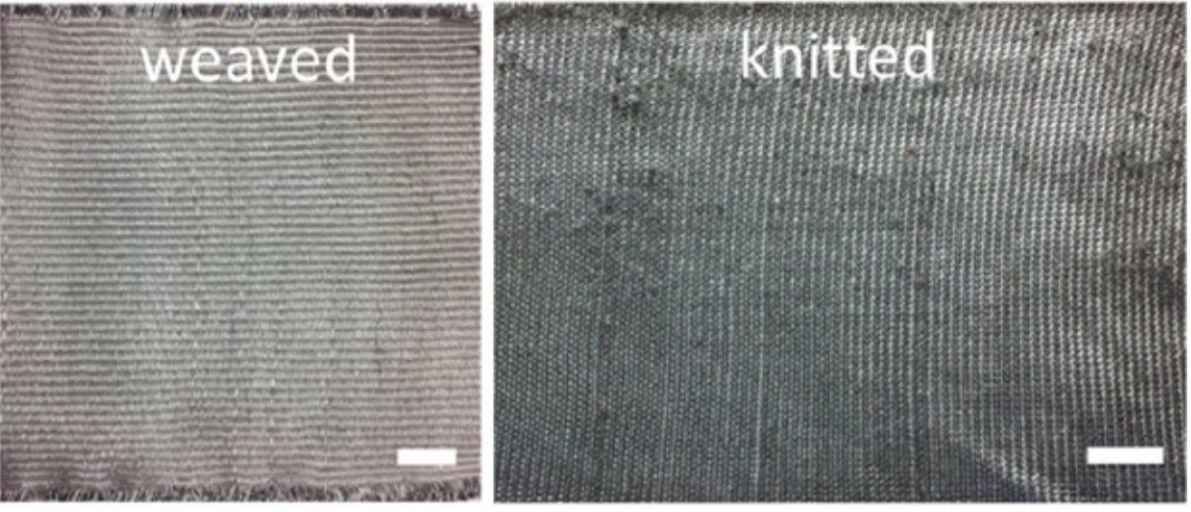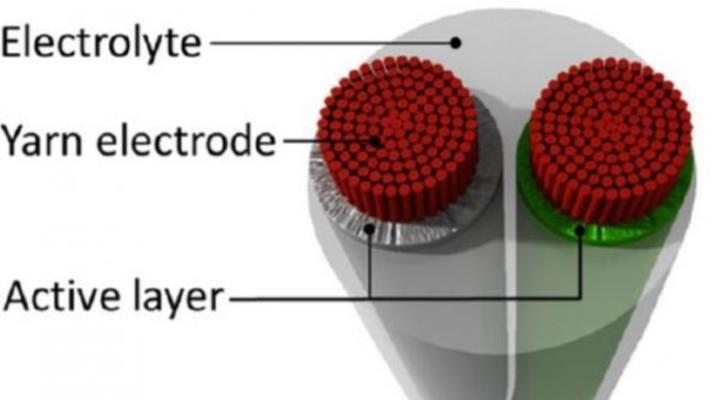Researchers knit and weave yarn battery for wearables
Removing the need for rigid and cumbersome batteries, a team of Chinese researchers has designed a rechargeable and flexible yarn-based battery that could be produced at scale on existing industrial knitting or weaving machines.

A free-standing solid-state yarn battery showing
two yarns electrodeposited with Zn (in grey) and
NCHO (shown in green) embedded into a
poly(vinyl alcohol)-based gel electrolyte.
Their paper "Weavable, Conductive Yarn-Based NiCo//Zn Textile Battery with High Energy Density and Rate Capability" recently published in the ACS Nano journal reports an intrinsically safe textile battery composed of pairs of stainless steel yarns electrodeposited with zinc (Zn) for the anode and nickel cobalt hydroxide (NCHO) for the cathode, jointly coated with a poly(vinyl alcohol)-based gel electrolyte.
The researchers used stainless steel 316L spun at high temperature to form micron-sized filaments, followed by a twist-bundle drawing technique, obtaining highly conductive continuous yarns (180 to 250?m in diameter) with a flexibility similar to that of cotton yarns. Those formed the basis for the two electrodes used in their yarn batteries.
Using industrial-grade knitting and weaving machines, the researchers demonstrated the dual (anode and cathode) yarns withstood well the conversion to highly conductive textiles.
For their conductive yarn-based NiCo//Zn textile battery, the researchers reported a high specific capacity of 5mAh cm-3 and energy densities of 0.12mWh cm-2 and 8mWh cm-3 and power densities of 32.8 mW cm-2 and 2.2 W cm-3 (all based on the solid battery).
These values are superior to most aqueous batteries and supercapacitors, claim the researchers.
The researchers also submitted their yarn battery to a series of deformation tests: straight, bent 95°, twisted 360°, and again straight, revealing that the charge curves almost overlap completely, and discharge curves as well as capacities do not change much at various deformation states.
Though cycling tests at different deformation states induced a slight capacity loss. 20% when bent 95° and 30% when twisted 360°, after 1000 cycles. The researchers attribute this capacity loss to the formation of crack on the electrode materials (being metal oxides).

A cloth woven by a CCI Rapier weaving machine (left)
and a cloth knitted by a STOLL knitting machine (right).
Scale bars: 1 cm.
As well as being easy to mass produce and weave, multiple yarn batteries were tested assembled in series (for a higher voltage) and in parallel to yield a higher current, showing excellent scalability.
To prove their textile battery concept, the researchers fabricated a wrist band battery made out of a large conductive cloth, connecting four textile batteries in series for a 4.8 to 8V operating window. The wrist band battery was able to power various electronic devices including a watch, a set of light emitting diodes, and a pulse sensor.
The researchers have applied for patents and are hoping to be able to commercialize their wearable textile battery concept.
By Julien Happich
